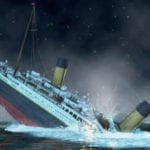 Weird Stuff
Weird Stuff  Weird Stuff
Weird Stuff  Our World
Our World 10 Ways Your Christmas Tree Is More Lit Than You Think
 Movies and TV
Movies and TV The 10 Coolest Stars to Set Sail on The Love Boat
 History
History 10 Things You Didn’t Know About the American National Anthem
 Technology
Technology Top 10 Everyday Tech Buzzwords That Hide a Darker Past
 Humans
Humans 10 Everyday Human Behaviors That Are Actually Survival Instincts
 Animals
Animals 10 Animals That Humiliated and Harmed Historical Leaders
 History
History 10 Most Influential Protests in Modern History
 Creepy
Creepy 10 More Representations of Death from Myth, Legend, and Folktale
 Technology
Technology 10 Scientific Breakthroughs of 2025 That’ll Change Everything
 Weird Stuff
Weird Stuff Ten Bizarre Facts About The Doge Meme
 Our World
Our World 10 Ways Your Christmas Tree Is More Lit Than You Think
 Movies and TV
Movies and TV The 10 Coolest Stars to Set Sail on The Love Boat
Who's Behind Listverse?

Jamie Frater
Head Editor
Jamie founded Listverse due to an insatiable desire to share fascinating, obscure, and bizarre facts. He has been a guest speaker on numerous national radio and television stations and is a five time published author.
More About Us History
History 10 Things You Didn’t Know About the American National Anthem
 Technology
Technology Top 10 Everyday Tech Buzzwords That Hide a Darker Past
 Humans
Humans 10 Everyday Human Behaviors That Are Actually Survival Instincts
 Animals
Animals 10 Animals That Humiliated and Harmed Historical Leaders
 History
History 10 Most Influential Protests in Modern History
 Creepy
Creepy 10 More Representations of Death from Myth, Legend, and Folktale
 Technology
Technology 10 Scientific Breakthroughs of 2025 That’ll Change Everything
10 Expeditions That Set Off in Hope but Ended in Disaster
You might imagine that exploratory expeditions set off with hope in their hearts. They may have been motivated by a burning desire to further human knowledge or the opening of new and lucrative trade routes. These ventures into the unknown are undoubtedly brave, but they can also be positively reckless. And all too often, they can end in disaster and even death. Here, we’ve collected ten tales of intrepid journeys that did not end well, to put it mildly.
Related: 10 Amazing Discoveries from Around the World
10 Mungo Park
Mungo Park had cut his teeth as an African explorer by traveling into the interior of Africa from Gambia via the Niger River in 1795. In an eventful journey that included a four-month imprisonment courtesy of an Arab sheik, Park managed to travel 200 miles (322 km) upriver. On his return to Britain after two years of adventure, hardship, and illness, he published a bestselling account of his trip, Travels in the Interior Districts of Africa.
Park’s next trip in 1805 was a grander affair as, with the help of government funding, he led a party of 40 men into the African interior for a second journey along the Niger River. The expedition did not go well. Many of Park’s team were stricken with disease—29 of them died—and a fire destroyed much of their supplies. That was before they’d even reached the Niger. Undeterred, Park and the remains of his party took to the river aboard canoes. The journey was now enlivened by attacks from the indigenous peoples and an angry hippo. Eventually, the canoes were smashed upon the rocks. There were no survivors.[1]
9 Salomon August Andrée
Swedish engineer Salomon August Andrée had his own unique idea. He decided it would make good sense to journey to the North Pole aboard a hydrogen balloon. With the blessing of his monarch, King Oscar II, he set off in 1896. Or at least he tried to. Unfavorable winds prevented a launch. Undaunted, Andrée tried again the following year and this time made it into the air from Danes Island in the Arctic Sea.
Accompanied by a two-strong crew, Andrée planned to head north across the Arctic wastes to the Pole. The three set off aboard the Eagle balloon in July 1897 and quickly met with severe difficulties, including the loss of the lines used to steer the balloon. After just two days, they were forced into an emergency landing on the ice. They had sleds and some supplies and now spent three months struggling across the barren floes. Andree’s diaries, retrieved later, showed that the three were dead by mid-October. Their bodies weren’t discovered until 1930.[2]
8 Jean-Francois de Galaup, Comte de La Pérouse
In 1785, King Louis XVI ordered the aristocrat Captain Jean-Francois de Galaup to sail around the world on a map-making expedition. Commanding two ships crewed by 225 men, La Pérouse made good progress, sailing from Brest on France’s west coast across the Atlantic to Cape Horn on the very tip of South America. After rounding the Horn, the party sailed north up the coast of the American continent. After reaching Alaska, La Pérouse then sailed for China, Japan, and the Philippines, arriving in Australia in 1788.
La Pérouse then embarked from Australia’s Botany Bay, but after that, no more was heard from him. The French sent off a search party, which made its way to Australia without finding any trace of the Captain or his men. In fact, it wouldn’t be until 1826 that news of the French expedition’s fate came to light. Irish mariner Peter Dillon landed on the southwest Pacific island of Vanikolo, where the islanders told him that years earlier, two ships had sunk nearby. The sailors had built a makeshift craft and set sail, never to be seen again.[3]
7 The Corte-Real Brothers
The three Portuguese Corte-Real brothers were Gaspar, Miguel, and Vasco. Gaspar achieved fame as an explorer in 1500 when he headed an expedition to Greenland, even though he believed he’d landed on the coast of East Asia. You would have thought that was a rather glaring error, but even so, Gaspar was lauded in his home country for his feat. The following year, Gaspar, this time with his brother Miguel, sailed back to Greenland with a flotilla of three ships.
However, only two ships returned to Portugal, and the missing vessel was the one with the Gaspar aboard. A devastated Miguel now mounted another trip to search for Gaspar. But then he, too, failed to return to his homeland. That left one brother, Vasca. Now, he decided to set off in search of his two missing siblings. But King Manuel I banned Vasca from accompanying another rescue mission. Two ships, minus Vasca, set off, and although both returned, they’d not found the missing Corte–Real brothers who were never seen again.[4]
6 Naomi Uemura
In 1970, Naomi Uemura had the singular distinction of being the first Japanese citizen to reach the summit of Mount Everest. His intrepid career as an adventurer also included a lone 470-mile (756.4-km) trek to the North Pole in 1978, which he accomplished in 57 days of traveling with dog sleds. During that trip, he’d been forced to shoot a marauding polar bear.
As well as that Everest ascent, Uemura scaled South America’s Mount Aconcagua, Africa’s Mount Kilimanjaro, and Europe’s Mont Blanc, all climbing solo. Plus, he’d ascended alone to the summit of North America’s highest peak, Mount Denali, formerly known as Mount McKinley. Then, in 1984, 14 years after he’d first climbed the Alaskan mountain, he returned to Denali for a second lone ascent. He reached the summit on the day of his 43rd birthday, radioing the news of his success. But that was the last message he sent, and he was never seen again, with his remains still undiscovered to this day.[5]
5 René-Robert Cavelier de La Salle
Born in 1643, René-Robert Cavelier de La Salle made his first trip out of his native France to Canada, then New France, as a Jesuit priest when he was 22. Some Mohawks there told him about a great river to the south, and La Salle left the priesthood to lead an expedition in search of this intriguingly rumored waterway. La Salle succeeded in discovering the Illinois, which he followed until it joined the Mississippi.
In 1684, La Salle planned a voyage to the mouth of the Mississippi, intending to found a colony there. He embarked from France with four ships and 300 men in 1684, but the expedition soon met with disaster. One ship was taken by pirates, another sunk, and a third turned tail and headed back to France. The final vessel, with La Salle aboard, ran aground 500 miles (805 km) from the Mississippi’s mouth at Matagorda Bay in Texas. La Salle set off overland to try and find the elusive river, but angered by the hardships of the journey, his men mutinied and killed their leader in 1687.[6]
4 George Bass
Born in England in 1771, George Bass joined the Royal Navy at the age of 18. Apparently, a young man with a taste for adventure, in 1794, he grabbed the chance to join HMS Reliance, which was about to depart for New South Wales in Australia. Once Bass was there, he and master’s mate Matthew Flinders made several expeditions along the Australian coast. One trip was through the sea that divides mainland Australia from the island of Tasmania, which is still known as the Bass Strait to this day.
After his Australian explorations, Bass, suffering from poor health, decided to pursue a career as a commercial trader. The Navy gave him a one-year term of medical leave, and in 1801, he set off from England aboard the Venus with some 10,000 pounds worth of goods, which he planned to sell at a profit. But market conditions in Australia meant he couldn’t sell his goods, so he decided to embark on a trip to South America to try his luck there. Bass sailed into the Pacific in February 1803, and nothing was ever heard of again.[7]
3 Peng Jiamu
Peng Jiamu, born in 1925, was a distinguished scientist and explorer who traveled extensively around his native China, journeying on foot, by donkey, or in a canoe when motorized transport was unavailable. He made several journeys across the Lop Desert, an arid and testing landscape notorious for its howling winds and temperatures as high as 120˚F (50˚C). Located in the Uigur Autonomous Region of Xinjiang in northwest China, the Lop was once an important hub on the ancient Silk Road.
On a 1980 expedition to the Lop, after five days of difficult progress across dunes and treacherous dried-out riverbeds, Peng’s party found themselves short of supplies and dangerously low on water. One morning, Peng’s comrades discovered that his tent was empty. He’d left a message saying he’d gone off on his own to look for water, but he never reappeared. Although the Chinese government organized thorough searches, Peng’s fate remains unknown to this day.[8]
2 Vitus Bering
Danish explorer Vitus Bering made his first foray as an expedition leader at the command of Russia’s Tsar Peter I in 1728. The tsar ordered Bering to find out if there was a land connection between Siberia and North America. Bering set off from Siberia’s Kamchatka peninsula and correctly concluded that there was no land bridge between Russia and Alaska.
Bering embarked on a second expedition from Kamchatka with two vessels in 1741. Bering captained the St. Peter, and his fellow explorer Aleksey Chirikov skippered the St. Paul. The two ships lost contact in heavy weather, and Bering ended up landing on the Commander Islands east of Kamchatka. There, he and many of his crew were stricken by scurvy, the severe illness caused by vitamin C deficiency and much feared by mariners. Many of the St. Peter’s sailors succumbed to the grim disease, as did Bering himself. However, his name lives on in the waters of the Bering Strait and the Bering Sea.[9]
1 Sir Hugh Willoughby
In a 1553 expedition in uncharted Arctic waters, Sir Hugh Willoughby went in search of the fabled Northeast Passage, which was believed would offer an alternative sea route to China. The discovery of such a passage would make access to Chinese markets much easier, potentially offering a lucrative commercial opportunity to British merchants. Willoughby set off with three ships, accompanied by Richard Chancellor, the only expedition member with navigational skills.
The ships were separated in a storm, with Chancellor aboard one vessel and Willoughby commanding the other two. Chancellor made it to Russia, where he was entertained by the emperor, Ivan the Terrible. Willoughby’s fate remained a mystery until a year after his disappearance when Russian fishermen made a gruesome discovery at the River Varzina estuary on northern Russia’s Kola Peninsula. Willoughby’s log was recovered and noted that his party had decided to bivouac there. But he and some 70 of his men perished in the depths of the freezing Arctic winter.[10]








